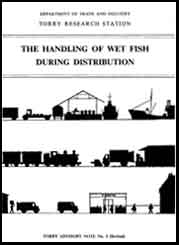
Contents Index

Accompanying Notes
Table of Contents
DEPARTMENT OF TRADE AND INDUSTRY
TORRY RESEARCH STATION
TORRY ADVISORY NOTE No. 3 (Revised)
Crown copyright material is reproduced with the permission of the Controller of Her Majesty's Stationery Office.
This electronic document has been scanned using optical character recognition (OCR) software and careful manual recorrection. Even if the quality of digitalisation is high, the FAO declines all responsibility for any discrepancies that may exist between the present document and its original printed version.
The term ‘wet’ fish is used in this Note to
refer to fish that have not been frozen, especially chilled fish, in order to avoid use of
the loose and ill-defined term ‘fresh’ fish. Read in conjunction with Notes 12, 16, 21
and 50. Emphasises the need to keep
wet fish properly chilled from port to shop as close to 0° C as possible. Explains the
use and misuse of chillrooms, gives practical advice on the effective use of ice on whole
(gutted) fish and fillets, and identifies at which points in the distribution chain rises
in temperature of the fish are more likely. Stresses the importance of cleanliness (Note 45).
(FAO in partnership with Support unit for International Fisheries and Aquatic Research, SIFAR, 2001).
Why fish go bad
Where bacteria come from
The effect of temperature
Keeping fish cool
How to handle the fish
Cleanliness and hygiene
Contents Index